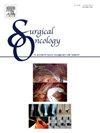非小细胞肺癌套筒肺叶切除术与全肺切除术后的长期生存率
IF 2.4
4区 医学
Q3 ONCOLOGY
引用次数: 0
摘要
比较袖状肺叶切除术和全肺切除术治疗中心位置非小细胞肺癌(NSCLC)的短期死亡率和长期总生存率。方法回顾性分析2009年至2023年在我院行非小细胞肺癌套筒肺叶切除术合并或不合并肺动脉成形术的患者。然后,我们对全国登记的肺切除术患者进行倾向评分匹配,并比较匹配前后的30天和90天死亡率和长期总生存率。使用独立检验比较死亡率,使用Kaplan-Meier估计和log-rank检验比较总生存率。结果本研究纳入套筒肺叶切除术患者109例,全肺切除术患者315例,两组各匹配60例。未匹配组和匹配组的30天和90天死亡率相似(未匹配组:3.7% vs 5.1%和5.5% vs 9.2%;匹配:5.0% vs 6.7%, 5.0% vs 12%。p值均为>;0.05)。未配对和配对袖叶切除术患者的总生存时间更长(未配对:风险比[HR] 0.52, 95%可信区间[CI] 0.37-0.73, p <;0.001;匹配HR 0.55, 95% CI 0.34-0.90, p = 0.018)。未匹配的袖状肺叶切除术和全肺切除术患者的5年总生存率分别为68%和49%,匹配的患者的5年总生存率分别为61%和42%。结论与全肺切除术相比,套筒肺叶切除术短期死亡率不低于全肺切除术,长期总生存率高于全肺切除术,在可行的情况下,应作为中心位置非小细胞肺癌的首选切除术。本文章由计算机程序翻译,如有差异,请以英文原文为准。
Long-term survival after sleeve lobectomy versus pneumonectomy for non-small cell lung cancer
Background
To compare short-term mortality and long-term overall survival between sleeve lobectomy and pneumonectomy for centrally located non-small cell lung cancer (NSCLC).
Methods
We retrospectively reviewed patients who had been radically resected for NSCLC by sleeve lobectomy with or without pulmonary arterioplasty at our institution between 2009 and 2023. We then propensity score-matched the patients with pneumonectomy counterparts from a national registry and compared their 30- and 90-day mortality and long-term overall survival before and after matching. The mortality was compared using independence tests and the overall survival using Kaplan-Meier estimates and the log-rank test.
Results
The study included 109 sleeve lobectomy patients and 315 pneumonectomy patients, of whom 60 patients from each group were matched. The 30- and 90-day mortality was similar between both the unmatched and matched groups (unmatched: 3.7 % vs 5.1 % and 5.5 % vs 9.2 %; matched: 5.0 % vs 6.7 % and 5.0 % vs 12 %. All p-values >0.05). The overall survival was longer in both the unmatched and matched sleeve lobectomy patients (unmatched: hazard ratio [HR] 0.52, 95 % confidence interval [CI] 0.37–0.73, p < 0.001; matched HR 0.55, 95 % CI 0.34–0.90, p = 0.018). The 5-year overall survival was 68 % and 49 % for the unmatched sleeve lobectomy and pneumonectomy patients, respectively, and 61 % and 42 % for the matched ones.
Conclusions
Sleeve lobectomy yields non-inferior short-term mortality and superior long-term overall survival compared with pneumonectomy and should be the resection of choice for centrally located NSCLC when feasible.
求助全文
通过发布文献求助,成功后即可免费获取论文全文。
去求助
来源期刊

Surgical Oncology-Oxford
医学-外科
CiteScore
4.50
自引率
0.00%
发文量
169
审稿时长
38 days
期刊介绍:
Surgical Oncology is a peer reviewed journal publishing review articles that contribute to the advancement of knowledge in surgical oncology and related fields of interest. Articles represent a spectrum of current technology in oncology research as well as those concerning clinical trials, surgical technique, methods of investigation and patient evaluation. Surgical Oncology publishes comprehensive Reviews that examine individual topics in considerable detail, in addition to editorials and commentaries which focus on selected papers. The journal also publishes special issues which explore topics of interest to surgical oncologists in great detail - outlining recent advancements and providing readers with the most up to date information.
 求助内容:
求助内容: 应助结果提醒方式:
应助结果提醒方式:


